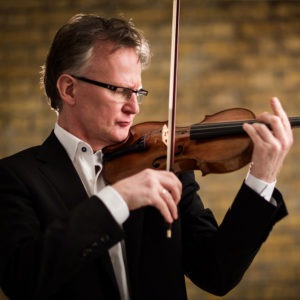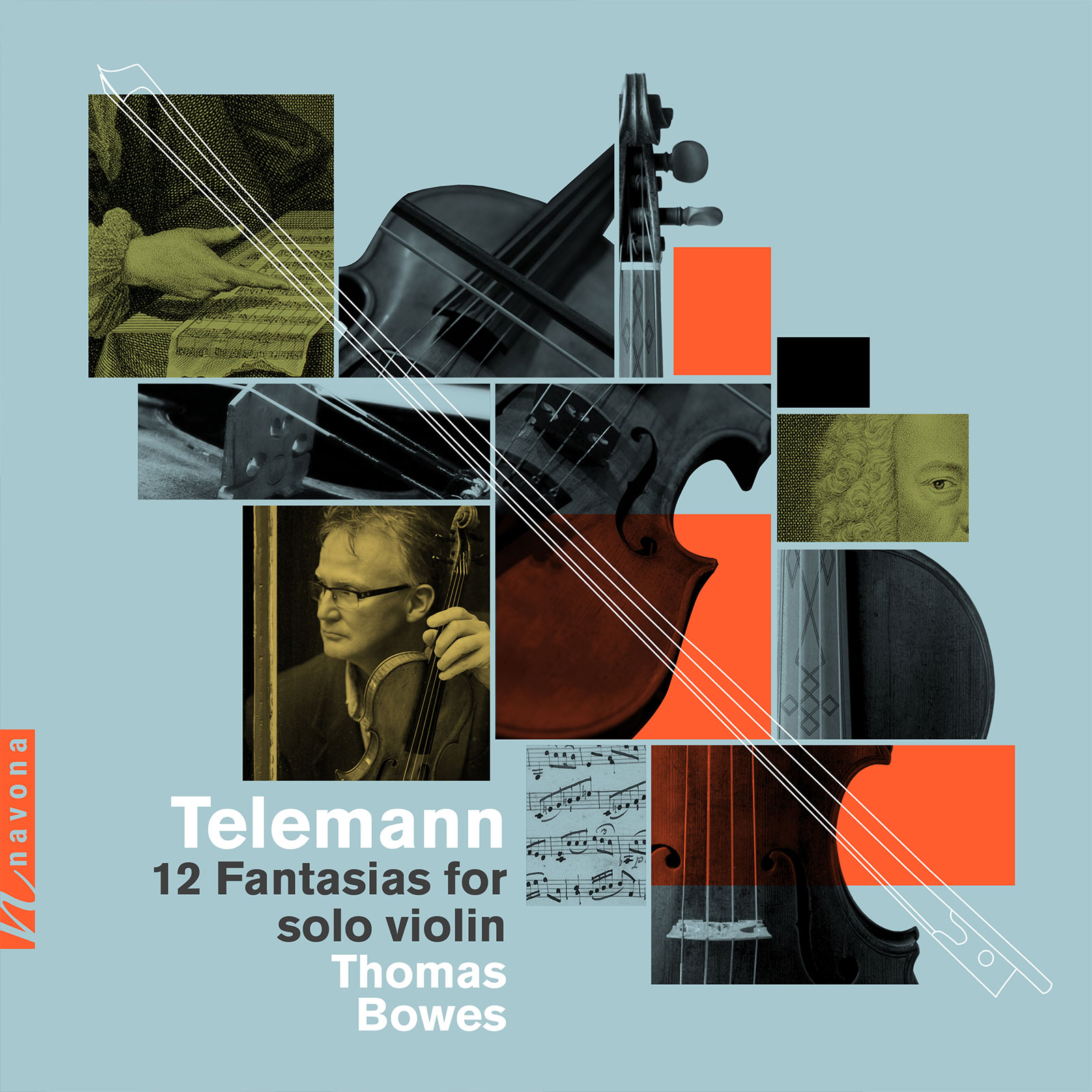Telemann Fantasias
Thomas Bowes violin
Pondering the Baroque violin repertoire, one would be forgiven to think of Johann Sebastian Bach’s works and little else. Acclaimed English violinist Thomas Bowes courageously sets out to change this preconceived notion with TELEMANN FANTASIAS, a rare and remarkable full performance of all of Georg Philipp Telemann’s solo violin fantasias.
Telemann is to violinists what Mozart is to keyboard players: deceptively simple on paper, notoriously difficult to master in actuality. Bowes, never a stranger to a challenging repertoire, expertly articulates the cheer, spirit, and zest of these pieces with a strikingly light-hearted panache, as if it could be no different. Indeed, upon listening to this rendition, it is easy to imagine a future in which public performances of Bach’s pious partitas are habitually rounded off by Telemann’s buoyant secular fantasias.
For Bowes, this future is now.
Listen
Stream/Buy
Choose your platform
"Bowes retains the upbeat and energetic nature of the compositions, and his meticulous execution makes every second here worth spending plenty of quality time with."
Track Listing & Credits
| # | Title | Composer | Performer | |
|---|---|---|---|---|
| 01 | Fantasia no. 1 in B flat major: Largo | Georg Philipp Telemann | Thomas Bowes, violin | 2:21 |
| 02 | Fantasia no. 1 in B flat major: Allegro | Georg Philipp Telemann | Thomas Bowes, violin | 1:45 |
| 03 | Fantasia no. 1 in B flat major: Grave | Georg Philipp Telemann | Thomas Bowes, violin | 1:18 |
| 04 | Fantasia no. 1 in B flat major: Allegro (da capo) | Georg Philipp Telemann | Thomas Bowes, violin | 1:45 |
| 05 | Fantasia no. 2 in G major: Largo | Georg Philipp Telemann | Thomas Bowes, violin | 1:47 |
| 06 | Fantasia no. 2 in G major: Allegro | Georg Philipp Telemann | Thomas Bowes, violin | 2:01 |
| 07 | Fantasia no. 2 in G major: Allegro | Georg Philipp Telemann | Thomas Bowes, violin | 0:56 |
| 08 | Fantasia no. 3 in F minor: Adagio | Georg Philipp Telemann | Thomas Bowes, violin | 1:56 |
| 09 | Fantasia no. 3 in F minor: Presto | Georg Philipp Telemann | Thomas Bowes, violin | 1:34 |
| 10 | Fantasia no. 3 in F minor: Grave-Vivace | Georg Philipp Telemann | Thomas Bowes, violin | 1:13 |
| 11 | Fantasia no. 4 in D major: Vivace | Georg Philipp Telemann | Thomas Bowes, violin | 1:42 |
| 12 | Fantasia no. 4 in D major: Grave | Georg Philipp Telemann | Thomas Bowes, violin | 0:38 |
| 13 | Fantasia no. 4 in D major: Allegro | Georg Philipp Telemann | Thomas Bowes, violin | 2:32 |
| 14 | Fantasia no. 5 in A major: Allegro-Presto-Allegro-Presto | Georg Philipp Telemann | Thomas Bowes, violin | 2:25 |
| 15 | Fantasia no. 5 in A major: Andante | Georg Philipp Telemann | Thomas Bowes, violin | 0:52 |
| 16 | Fantasia no. 5 in A major: Allegro | Georg Philipp Telemann | Thomas Bowes, violin | 2:27 |
| 17 | Fantasia no. 6 in E minor: Grave | Georg Philipp Telemann | Thomas Bowes, violin | 2:33 |
| 18 | Fantasia no. 6 in E minor: Presto | Georg Philipp Telemann | Thomas Bowes, violin | 1:37 |
| 19 | Fantasia no. 6 in E minor: Siciliana | Georg Philipp Telemann | Thomas Bowes, violin | 2:07 |
| 20 | Fantasia no. 6 in E minor: Allegro | Georg Philipp Telemann | Thomas Bowes, violin | 2:38 |
| 21 | Fantasia no. 7 in E flat major: Dolce | Georg Philipp Telemann | Thomas Bowes, violin | 2:13 |
| 22 | Fantasia no. 7 in E flat major: Allegro | Georg Philipp Telemann | Thomas Bowes, violin | 3:10 |
| 23 | Fantasia no. 7 in E flat major: Largo | Georg Philipp Telemann | Thomas Bowes, violin | 2:30 |
| 24 | Fantasia no. 7 in E flat major: Presto | Georg Philipp Telemann | Thomas Bowes, violin | 1:05 |
| 25 | Fantasia no. 8 in E major: Piacevolmente | Georg Philipp Telemann | Thomas Bowes, violin | 1:40 |
| 26 | Fantasia no. 8 in E major: Spirituoso | Georg Philipp Telemann | Thomas Bowes, violin | 2:47 |
| 27 | Fantasia no. 8 in E major: Allegro | Georg Philipp Telemann | Thomas Bowes, violin | 1:14 |
| 28 | Fantasia no. 9 in B minor: Siciliana | Georg Philipp Telemann | Thomas Bowes, violin | 1:27 |
| 29 | Fantasia no. 9 in B minor: Vivace | Georg Philipp Telemann | Thomas Bowes, violin | 2:46 |
| 30 | Fantasia no. 9 in B minor: Allegro | Georg Philipp Telemann | Thomas Bowes, violin | 1:55 |
| 31 | Fantasia no. 10 in D major: Presto | Georg Philipp Telemann | Thomas Bowes, violin | 1:46 |
| 32 | Fantasia no. 10 in D major: Largo | Georg Philipp Telemann | Thomas Bowes, violin | 2:14 |
| 33 | Fantasia no. 10 in D major: Allegro | Georg Philipp Telemann | Thomas Bowes, violin | 1:22 |
| 34 | Fantasia no. 11 in F major: Un poco vivace | Georg Philipp Telemann | Thomas Bowes, violin | 1:57 |
| 35 | Fantasia no. 11 in F major: Soave | Georg Philipp Telemann | Thomas Bowes, violin | 1:17 |
| 36 | Fantasia no. 11 in F major: Un poco vivace (da capo) | Georg Philipp Telemann | Thomas Bowes, violin | 1:48 |
| 37 | Fantasia no. 11 in F major: Allegro | Georg Philipp Telemann | Thomas Bowes, violin | 1:09 |
| 38 | Fantasia no. 12 in A minor: Moderato | Georg Philipp Telemann | Thomas Bowes, violin | 1:50 |
| 39 | Fantasia no. 12 in A minor: Vivace | Georg Philipp Telemann | Thomas Bowes, violin | 1:34 |
| 40 | Fantasia no. 12 in A minor: Presto | Georg Philipp Telemann | Thomas Bowes, violin | 1:10 |
Recorded November 17-19, 2020 at Wyastone Concert Hall, Monmouth UK
Recording session producer Stephen Frost
Recording session engineer Arne Akselberg
Editor Stephen Frost
Microphone list
DPA 4006 (pair)
Neumann TLM 50 (pair)
Neumann TLM 170 (pair)
DPA 4015 (pair)
AEA R84
Photography Ben Ealovega
General Manager of Audio & Sessions Jan Košulič
Audio Director Lucas Paquette
Executive Producer Bob Lord
Executive A&R Sam Renshaw
A&R Director Brandon MacNeil
A&R Danielle Lewis
VP, Design & Marketing Brett Picknell
Art Director Ryan Harrison
Design Edward A. Fleming
Publicity Patrick Niland, Sara Warner
Artist Information

Thomas Bowes
Thomas Bowes is one of the United Kingdom’s finest violinists. He is very active in the realm of cinema, and millions have heard him on the soundtracks of his 200+ film credits. Most recently he was featured as the solo violinist in Alexandre Desplat’s score for Guillermo del Toro’s award-winning stop-motion film Pinocchio.
Arne Akselberg
Arne Akselberg is a multiple Grammy Award–winning engineer who works regularly with some of the biggest composers and artists worldwide, including Leif Ove Andsnes, Ian Bostridge, the Belcea Quartet, Maxim Vengerov, and Sir Paul McCartney.
Stephen Frost
Stephen Frost is a film director, composer, and music producer. He has been producing and editing classical music recordings for over 30 years, bringing him into close contact with some of the most eminent music makers of the late 20th and early 21st centuries.


